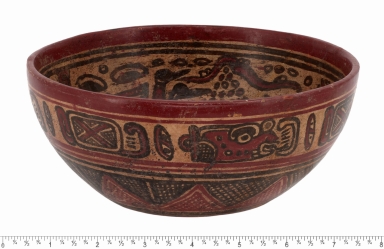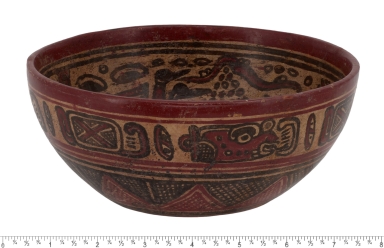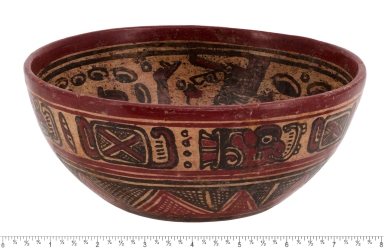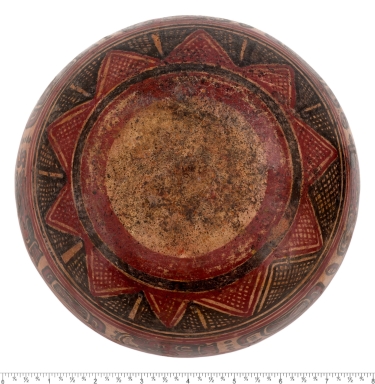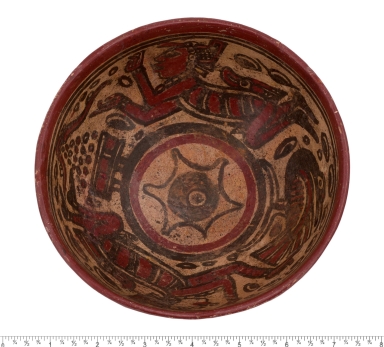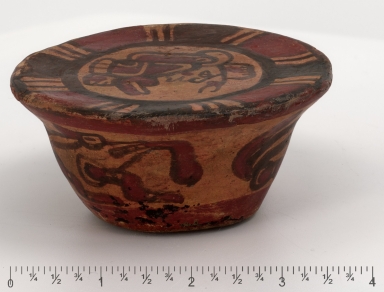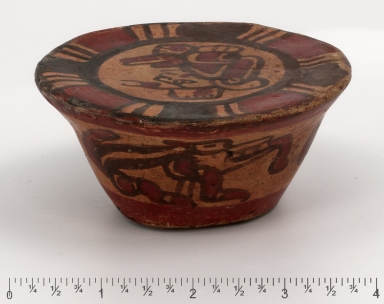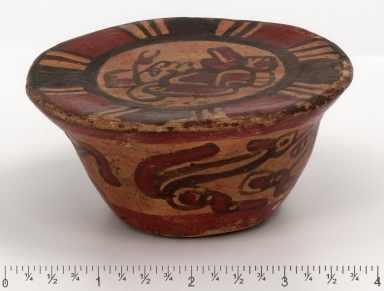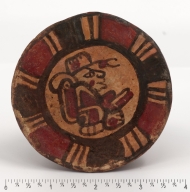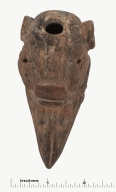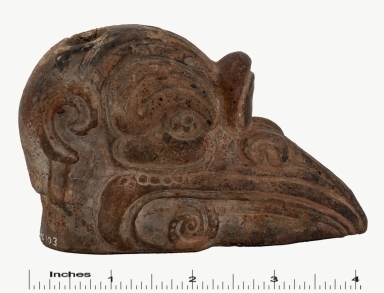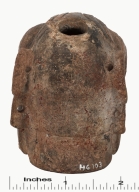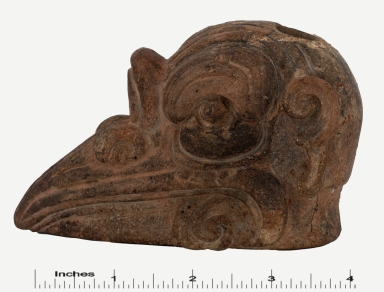|
|
REFINE
Browse All : Artifact and Pottery--Central America
1-18 of 18
Title
Maya copador swimmer bowl.
Description
The number three appears to have significance. It appears as three legs, three solid bands, three stepped spiral rings and two of those rings are divided into three quadrants. There are three realms in Mesoamerica: Heaven, the Sky, Earth, the living world, and the Underworld, the land of the dead.
Subject
[Ceramic bowls--Central America, Pottery--Central America, Indigenous peoples--Antiquities, Maya art--Central America, Mayas--Antiquities]
Date
between 900 and 1400
Title
Maya copador swimmer bowl.
Description
The number three appears to have significance. It appears as three legs, three solid bands, three stepped spiral rings and two of those rings are divided into three quadrants. There are three realms in Mesoamerica: Heaven, the Sky, Earth, the living world, and the Underworld, the land of the dead.
Subject
[Ceramic bowls--Central America, Pottery--Central America, Indigenous peoples--Antiquities, Maya art--Central America, Mayas--Antiquities]
Date
between 900 and 1400
Title
Maya copador swimmer bowl.
Description
The number three appears to have significance. It appears as three legs, three solid bands, three stepped spiral rings and two of those rings are divided into three quadrants. There are three realms in Mesoamerica: Heaven, the Sky, Earth, the living world, and the Underworld, the land of the dead.
Subject
[Ceramic bowls--Central America, Pottery--Central America, Indigenous peoples--Antiquities, Maya art--Central America, Mayas--Antiquities]
Date
between 900 and 1400
Title
Maya copador swimmer bowl.
Description
The number three appears to have significance. It appears as three legs, three solid bands, three stepped spiral rings and two of those rings are divided into three quadrants. There are three realms in Mesoamerica: Heaven, the Sky, Earth, the living world, and the Underworld, the land of the dead.
Subject
[Ceramic bowls--Central America, Pottery--Central America, Indigenous peoples--Antiquities, Maya art--Central America, Mayas--Antiquities]
Date
between 900 and 1400
Title
Maya copador swimmer bowl.
Description
The number three appears to have significance. It appears as three legs, three solid bands, three stepped spiral rings and two of those rings are divided into three quadrants. There are three realms in Mesoamerica: Heaven, the Sky, Earth, the living world, and the Underworld, the land of the dead.
Subject
[Ceramic bowls--Central America, Pottery--Central America, Indigenous peoples--Antiquities, Maya art--Central America, Mayas--Antiquities]
Date
between 900 and 1400
Title
Maya copador swimmer bowl.
Description
The number three appears to have significance. It appears as three legs, three solid bands, three stepped spiral rings and two of those rings are divided into three quadrants. There are three realms in Mesoamerica: Heaven, the Sky, Earth, the living world, and the Underworld, the land of the dead.
Subject
[Ceramic bowls--Central America, Pottery--Central America, Indigenous peoples--Antiquities, Maya art--Central America, Mayas--Antiquities]
Date
between 900 and 1400
Title
Macehead (scepter head) or jar top with seated elite and three canines (coyotes).
Description
This ceremonial object could be the top of a jar, a staff, a scepter or a macehead. On the top of the form, there is a seated elite figure holding his hand out. The slanted side is decorated with three canines, possibly dogs or coyotes. The style of the object is called Copador, which was made in El Salvador or Honduras.
Subject
[Ceramic tableware--Central America, Pottery--Central America, Art--Central America, Indigenous peoples--Antiquities]
Date
between 600 and 900
Title
Macehead (scepter head) or jar top with seated elite and three canines (coyotes).
Description
This ceremonial object could be the top of a jar, a staff, a scepter or a macehead. On the top of the form, there is a seated elite figure holding his hand out. The slanted side is decorated with three canines, possibly dogs or coyotes. The style of the object is called Copador, which was made in El Salvador or Honduras.
Subject
[Ceramic tableware--Central America, Pottery--Central America, Art--Central America, Indigenous peoples--Antiquities]
Date
between 600 and 900
Title
Macehead (scepter head) or jar top with seated elite and three canines (coyotes).
Description
This ceremonial object could be the top of a jar, a staff, a scepter or a macehead. On the top of the form, there is a seated elite figure holding his hand out. The slanted side is decorated with three canines, possibly dogs or coyotes. The style of the object is called Copador, which was made in El Salvador or Honduras.
Subject
[Ceramic tableware--Central America, Pottery--Central America, Art--Central America, Indigenous peoples--Antiquities]
Date
between 600 and 900
Title
Macehead (scepter head) or jar top with seated elite and three canines (coyotes).
Description
This ceremonial object could be the top of a jar, a staff, a scepter or a macehead. On the top of the form, there is a seated elite figure holding his hand out. The slanted side is decorated with three canines, possibly dogs or coyotes. The style of the object is called Copador, which was made in El Salvador or Honduras.
Subject
[Ceramic tableware--Central America, Pottery--Central America, Art--Central America, Indigenous peoples--Antiquities]
Date
between 600 and 900
Title
Macehead (scepter head) or jar top with seated elite and three canines (coyotes).
Description
This ceremonial object could be the top of a jar, a staff, a scepter or a macehead. On the top of the form, there is a seated elite figure holding his hand out. The slanted side is decorated with three canines, possibly dogs or coyotes. The style of the object is called Copador, which was made in El Salvador or Honduras.
Subject
[Ceramic tableware--Central America, Pottery--Central America, Art--Central America, Indigenous peoples--Antiquities]
Date
between 600 and 900
Title
Macehead (scepter head) or jar top with seated elite and three canines (coyotes).
Description
This ceremonial object could be the top of a jar, a staff, a scepter or a macehead. On the top of the form, there is a seated elite figure holding his hand out. The slanted side is decorated with three canines, possibly dogs or coyotes. The style of the object is called Copador, which was made in El Salvador or Honduras.
Subject
[Ceramic tableware--Central America, Pottery--Central America, Art--Central America, Indigenous peoples--Antiquities]
Date
between 600 and 900
Title
Maya avian head poison bottle.
Description
A rare earthenware bottle depicting a stylized avian deity's head having a large slightly curved beak, large lidded eyes, curled fangs, and human type ears. The drilled perforations in his ears and at the top of the eyes probably once held decorative elements.
Subject
[Pottery--Central America, Ceramic tableware--Central America, Maya art--Central America, Mayas--Antiquities, Indigenous peoples--Antiquities]
Date
between 500 and 800
Title
Maya avian head poison bottle.
Description
A rare earthenware bottle depicting a stylized avian deity's head having a large slightly curved beak, large lidded eyes, curled fangs, and human type ears. The drilled perforations in his ears and at the top of the eyes probably once held decorative elements.
Subject
[Pottery--Central America, Ceramic tableware--Central America, Maya art--Central America, Mayas--Antiquities, Indigenous peoples--Antiquities]
Date
between 500 and 800
Title
Maya avian head poison bottle.
Description
A rare earthenware bottle depicting a stylized avian deity's head having a large slightly curved beak, large lidded eyes, curled fangs, and human type ears. The drilled perforations in his ears and at the top of the eyes probably once held decorative elements.
Subject
[Pottery--Central America, Ceramic tableware--Central America, Maya art--Central America, Mayas--Antiquities, Indigenous peoples--Antiquities]
Date
between 500 and 800
Title
Maya avian head poison bottle.
Description
A rare earthenware bottle depicting a stylized avian deity's head having a large slightly curved beak, large lidded eyes, curled fangs, and human type ears. The drilled perforations in his ears and at the top of the eyes probably once held decorative elements.
Subject
[Pottery--Central America, Ceramic tableware--Central America, Maya art--Central America, Mayas--Antiquities, Indigenous peoples--Antiquities]
Date
between 500 and 800
Title
Maya avian head poison bottle.
Description
A rare earthenware bottle depicting a stylized avian deity's head having a large slightly curved beak, large lidded eyes, curled fangs, and human type ears. The drilled perforations in his ears and at the top of the eyes probably once held decorative elements.
Subject
[Pottery--Central America, Ceramic tableware--Central America, Maya art--Central America, Mayas--Antiquities, Indigenous peoples--Antiquities]
Date
between 500 and 800
Title
Maya avian head poison bottle.
Description
A rare earthenware bottle depicting a stylized avian deity's head having a large slightly curved beak, large lidded eyes, curled fangs, and human type ears. The drilled perforations in his ears and at the top of the eyes probably once held decorative elements.
Subject
[Pottery--Central America, Ceramic tableware--Central America, Maya art--Central America, Mayas--Antiquities, Indigenous peoples--Antiquities]
Date
between 500 and 800
1-18 of 18
|

